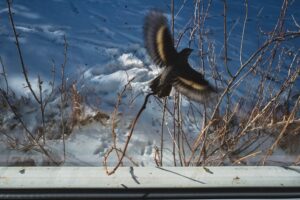The Townsend’s Solitaire defends two worlds —
the juniper grove and its reflection.
Endlessly he sings on the sill between.

That first winter after my brother died unexpectedly in fall 2022, a poet invited me to a private artist retreat on her ranch. It was near the Badlands in my home state of South Dakota, where I came of age and where my elderly parents still live. Dominated by space and solitude and silence, the Badlands during its often blustery and bone-chilling off-season is my favorite time to write, to photograph, and to bird-watch. If I’m fortunate enough, I can catch a glimpse of one of the local pairs of nesting great horned owls.
Yet that January when I left Wellfleet to head west, I didn’t realize that I’d also be spending time with a Townsend’s solitaire. Often seen alone, as its name suggests, this medium-sized thrush, which breeds from Alaska to the Rockies, is a winter migrant in the Badlands and surrounding grasslands, where individuals stake out their own juniper patch to sustain them during the coldest months and aggressively defend it from cedar waxwings and other berry-eating rivals. During my week at the poet’s ranch, one particular bird serenaded me on the windowsill near my writing desk.
By the second day, I walked outside in the snow to try to better understand the insistent behavior of this bird that was new to me. Standing in the snow, I saw a reflection of a row of trees — a juniper windbreak — in the picture window. It took me a moment to piece together that the Townsend’s solitaire was probably trying to protect what he perceived as two juniper groves — the actual windbreak sheltering the house as well as the grove’s reflection in the window. It’s a visual error, I later learned, shared by many birds.
Near the end of my stay, I came to see the Townsend’s solitaire as a kindred soul, for while grieving, I also often felt that I was suspended between two worlds — the Badlands and my own inner landscape, a creative terrain I think of as the geography of loss.
The photograph is from Rebecca Norris Webb’s book A Difficulty Is a Light, published in 2024 by Chose Commune. The three lines that open this essay are from her poem “Badlands.” Webb describes the book as a “hybrid poetry book, punctuated by 15 of my photographs.” Along with images of interiors and landscapes, photographs of birds appear throughout, usually depicted in flocks but also in solitude. The observation of their migrations echoes Webb’s emphasis on transitory states: between life and death, memory and the present, and geographies from Wellfleet to Trieste. —Abraham Storer



